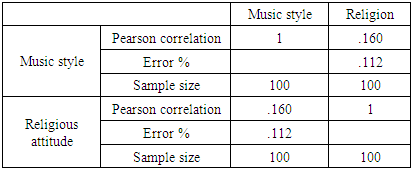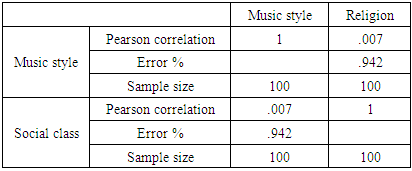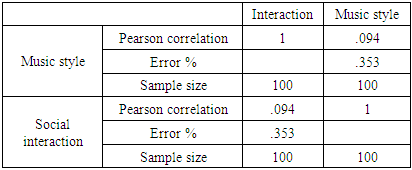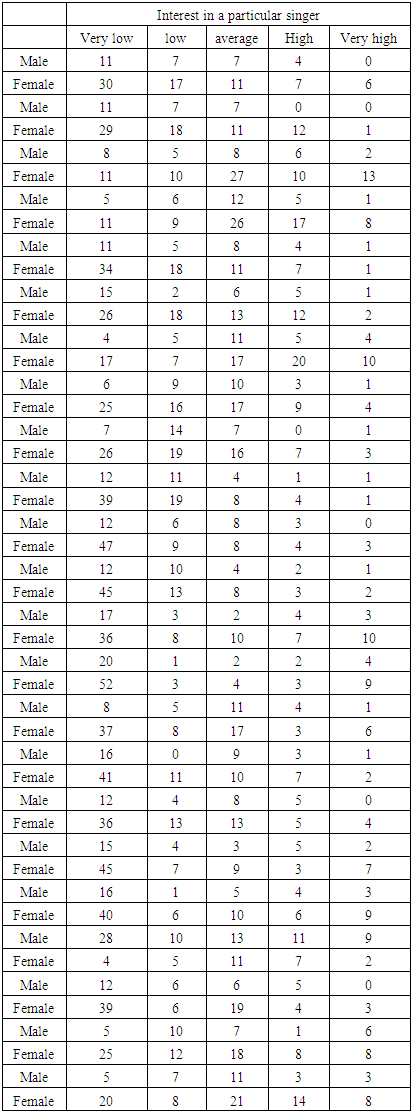-
Paper Information
- Paper Submission
-
Journal Information
- About This Journal
- Editorial Board
- Current Issue
- Archive
- Author Guidelines
- Contact Us
American Journal of Sociological Research
p-ISSN: 2166-5443 e-ISSN: 2166-5451
2019; 9(1): 9-13
doi:10.5923/j.sociology.20190901.02

A Study on the Level of Music Consumption and the Popular Music Style among the Youth
Seyedsaeed Aboozarian
Bachelor of Social Sciences, Department of Social Sciences (Social Sciences Research), University of Payame Noor, Mashhad, Iran
Correspondence to: Seyedsaeed Aboozarian, Bachelor of Social Sciences, Department of Social Sciences (Social Sciences Research), University of Payame Noor, Mashhad, Iran.
| Email: |  |
Copyright © 2019 The Author(s). Published by Scientific & Academic Publishing.
This work is licensed under the Creative Commons Attribution International License (CC BY).
http://creativecommons.org/licenses/by/4.0/

As the main consumers of music, young people can be considered as members of subculture(s) who tend to and adhere to music consumption. The variables of cultural capital and class differences play an effective role in music consumption, but the conditions of the new society have allowed other variables to influence the tastes. The main objective of this research is to investigate the popularity of different music styles among the youth and teenagers in Mashhad. The method used is survey using a questionnaire. The statistical population included 2541841 adolescents and youths in Mashhad, of whom 100 were selected as the sample using Cochrane formula. The sampling method was simple random selection. The results of this study showed that there is no significant relationship between gender, age, religious attitude and religious beliefs, social interactions of individuals and social class with type of consumed music style.
Keywords: Music, Music style, Youth, Interest in music
Cite this paper: Seyedsaeed Aboozarian, A Study on the Level of Music Consumption and the Popular Music Style among the Youth, American Journal of Sociological Research, Vol. 9 No. 1, 2019, pp. 9-13. doi: 10.5923/j.sociology.20190901.02.
Article Outline
1. Introduction
- Among arts, music has been extremely penetrating and enormously attracted by humanity due to energy generation, mobility, the possibility of abstraction and intrinsic gravity. There are various types of music, each of which has different effects on the mind and body. Due to these effects, music can be used for therapeutic purposes in the field of counseling and psychotherapy (Zadeh Mohamadi 2010).Providing an academic definition of music has been the subject of debate among scholars for centuries. Yet there is no definition of music that is widely accepted by the practitioners in this art. According to one of the most accepted definitions, music refers to the sounds that are consciously produced (Purtorab, 2010).Haji Hasani and Kianipour (2011) showed that music therapy has a significant effect on increased expression.Music is one of the most effective tools to increase the level of ingenuity, consciousness and mental power. Music greatly affects thinking and type of learning, which results in significant changes in the lives of individuals. Music as a comprehensive distinct curriculum can lead to significant positive effects on the learning process of young people.What has made music popular in the life of human beings more than any other art is the unique characteristic given to it by its non-artistic aspect. Music has the potential and ability to change its status (from art to entertainment and fun).The music that fails to be scientific scholarly or transcendental will certainly not address serious issues of culture, preservation of identity and the health of the community and will rather result in any pessimism, depression and anxiety. Because a reasonable fair balance between serious and popular music has not been established (Kiani, 2003).A music-loving youth approaches virtual and immediate remedies to stimulate and sooth their emotions. The person who seeks his demands from life in "music" never bothers himself, his mind and his will to see and figure out where he has calculated wrong and what are the barriers in his life. Cassidy and McDonald in 2007 studied the effect of music on introvert and extrovert students aimed at examining the effects of music with a potentially high stimulation level and negative affection and music with a low potential of stimulation and positive affection and everyday noise on cognitive performance. The results showed that extroverts are generally more influenced by the conditions in which there are high stimulation, music or noise.The main and primary purpose of music is to influence the behavior and attitudes of the person. If a person listens to lyrical music, while this music is upsetting it cannot help them think since it's too hard for the mind to overcome it. When a person listens to the background music, it's important that the music is familiar and desired, and also relaxing. Many years, musical pieces were created exclusively for the purpose of relaxation and stress reduction. Studies have shown that relaxation music reduces tensions, but listening to selective music has a better and more beneficial effect. Another study was conducted on 205 people to show the effects of minor and major music. Minor note (the small step) gives a person a sense of melancholy, grief and despair, and major note (the big step) often gives a feeling of happiness, cheerfulness, pleasure and awareness to the person. (Center Ministry Studies Sports and Youth of Iran, 2013)The head of Research Center of the Ministry of Sports and Youth of mashhad announced the rate of listening to CDs and audio tapes for every youth in the entire statistical population is 78 minutes a day, and added: the most popular music among youth is Iranian pop music and foreign music. The average time to listen to music is one hour and fifteen minutes a day.70 percent of respondents listen to music comprised of 49 percent traditional music, 47 percent domestic Iranian pop products, and 30 percent Iranian pop produced abroad. Music listeners listen to music in recorder (70%), VCD players (37%) radio and television (28%), computer (20%), and mobile phones (20%).Many new styles are innovated in the world of music (such as rock and metal), although in Iran these styles are not officially allowed to be produced; but underground networks are active in the production of this kind of music. Besides, the productions outside borders easily enter the country.The characteristics and effects of these styles on mental health and mind are very different from the traditional ones, which can be predicted according to the characteristics of each style although they are not scientifically investigated (Ghasemi, 2006: 76).
2. Musical Styles
- 1- Folk MusicFolk music is in fact the local music that simply expresses traditions and emotions. Country music has a very simple style, with themes, melodies and lyrics similar to blues genre. Most of the songs in this genre are based on several simple chords and a simple linear melody. In spite of its simplicity, this form of music has created a very different style.2- Hip-hop/RapThis music can also be considered as a sub-style of traditional R&B music. The early days of music began in the United States in the early 1970s. The first works of Rap came to the fore in the late 70s and early 80s. These songs are now known as Old School Hip-Hop. Rap music progressed rapidly both in the eastern and western regions, and quickly became one of the most popular musical styles. The main center of this music is in the east of New York City and in the west of Los Angeles. In the beginning years of this music, the eastern regions had a greater impact on this style, but gradually, in the early 90s, this style directed toward West. With the spread of this style, it quickly spread out into many branches, some was based on form and others were based on geographic and racial segregation. Alternative Hip-Hop music was one of the styles that gained popularity in the late 1990s and provided the ground for the emergence of Jazz-Rap genre. This music quickly crossed the borders of United States and found strong bases in countries such as Britain, France, Germany, Turkey, Mexico, and more.It has been combined with various styles like Heavy Metal and Electronica, each of which led to many sub-branches. Hardcore is also another branch of this music that has found great popularity.
2.1. Electronica
- This style of disco and funk music dates back to the early seventies. In these styles, for the first time, electronic instruments were used widely to perform the music, and this process continued until a completely new form emerged out of these styles. Cities of Chicago, Detroit and New York are the first regions that witnessed the performance of styles like Techno in the late 80s. This style of music has also grown dramatically in Britain and has now become one of the most popular pop styles. Despite the fact that this style was originally a kind of dance music, gradually producers began to experience more relaxed and milder styles to penetrate into houses.3- Rock/ Rock and RoleThe rock music has a very large scope, and this style can be described as the most popular style that emerged in the 1950s. The first rock and roll instances appeared in the late 40s.4- PopThere are a lot of definitions for pop music, but it is best defined as "the music coming from the heart of society and people." Here, it is divided into two types of Iranian and Western Pop. The distinctive feature of pop music is its joyful hilarious themes and its relaxing aspect. As we know, not all people have similar perceptions but when a piece is made in pop style, it must come from the heart of society whether joyful or even sad, and give people happiness or the sense of relief when they listen to it. In another definition derived from the basic definition of this style, it can be said that Pop is a style consisting of several styles of music. The pop music is usually defined as music with commercial purposes, or for financial revenue.Of course, pop music can also be analyzed in terms of market, ideology, production, and aesthetics. In fact, "pop" is designed to be interesting to everyone and is not rooted in any particular place, and is not intended to promote a particular taste. This music was not originated from any meaningful ambition, and the only ambitions of its makers are profit and material rewards. And, according to musical definitions, it is also very conservative.Pop music is something that is made up from above (record companies, radio producers and advertisement managers) and does not come from among the people. Pop is professionally prepared and packaged, and there is nothing that can be changed or modified according to taste. In other words, pop music that began in the 1950s is usually interesting for a large group of people. With the advent of plastic or vinyl plates in the 1930s to the advent of CDs in the 1980s, recorded music became more accessible than live music compared to the past.The pop songs are usually performed in 3 minutes, and they use melodies that are usually very audible and attract a lot of people. The distinct characteristic of pop music is a heavy rhythmic element which is usually performed by electronic amplifier devices and the main melody dominates this rhythm. The pop song also refers to popular songs that people are fond of whispering and singing.Pop music is commercially successful and is a favorite style of radio stations because it is accessible, easy to remember and attracts many audiences. Pop music concerts often attract so many spectators which only can be performed in big stadiums.Since the academic environment is a place built based on the power of reason and thought, and of course the sense of scientific participation which has the mission of advancing the community towards a better world; therefore, a high concentration of the brain and the development of a sense of relaxation to reduce the marginal issues of life for students and of course, the relevant authorities is vital. This way, the university's output will also have a higher quality and will better lead the national macro policies.Firoozeh Sepehrian Azar and Afsaneh Ketabi conducted a research on the effect of music, noise and silence background on the performance of introvert and extrovert female students in the academic talent test in 2013. In this study, the effect of the former environment’s sound as the moderating variable was studied. Results showed that the introverts have a better performance in silence and extroverts with a background of music, however the performance of both the introvert and extrovert groups was worse in the condition of noise compared to the silence and music played conditions. Moreover, the condition of the previous study environment had no significant effect on students’ performance.In a study on the effect of music on general reasoning and students' intellectual ability and IQ, the results showed that the experimental group had a significant difference with control group in terms of increased general reasoning ability (measured by the IQ and the total score of Stanford-Binet Intelligence Scale). In sub-tests, it was observed that music education increased the ability of verbal reasoning and strengthened the short-term memory of children, but regarding the ability of visual/abstract reasoning, despite the increase in the average raw scores of both groups in the post-test (compared to the pre-test), there was no significant difference in the level of changes in the two groups (Mirbaha et al., 2004).Bilhartz and colleagues studied the impact of music on cognitive development in 2000. The purpose of this study was to investigate the impact of music using the attention to the factor of social class and different economic levels through Stanford-Binet Intelligence test. The findings of this study indicated a significant increase in cognitive development, general reasoning and spatial-temporal abilities among the children in the experiment group compared to the control group, and the correlation was stronger in children with higher family income.For this reason, we aimed to highlight the benefits of music for thinking power and creating a sense of tranquility, as well as for identifying the objective academic instances, and distinguishing and redefining the positivist music versus discordant sounds that impose themselves on the younger generation in the name of music. It is necessary to find a way for better interaction of art of music with the students, and beyond that, to systematize the place of music in academic places. In particular, according to the place of academicians in the society, it can be said that the attitude and constructive interaction of this group with music will raise the status of true artists in the society. Therefore, the present study seeks to examine the popularity and style of music used by college youth.
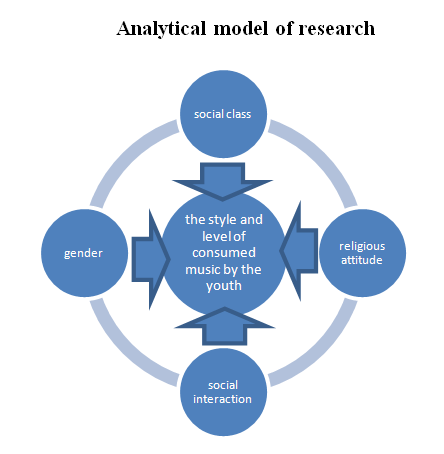 | Diagram 1. Research Conceptual Model |
3. Research Methodology
- The research method used in this study is survey method. Data collection is done through questionnaire, which is designed from a number of propositions about the research hypotheses, and since the respondents are not homogenous in terms of occupation and education, therefore, male and female respondents were entered the study. At the beginning of the questionnaire, a short introduction on the subject of research to gain the respondents’ trust is provided and it is tried to encourage the respondents to honest and sincere cooperation.The statistical population in this study includes the youth of Mashhad, residing in all districts of Mashhad. Of the total population of Mashhad including 2541841 people, 506681 are in the youth age group. To save time, Based on the influence of music among young people, from a total of 506681 people in the statistical population 100 youth were randomly selected as the statistical sample and were asked to answer the questionnaire carefully.SPSS v.21 was used to analyze the data.Research hypotheses- There is a significant relationship between music styles and gender.- There is a significant relationship between religious attitude and the amount and consuming music and music style.- There is a significant relationship between the social class of people and the choice of music style.- There is a significant relationship between the level of social interactions and the choice of music style.Sub hypothesis- The rate of listening to music is higher among women.
4. Data Analysis and Findings
- 1. Analysis of the correlation between music styles and gender
|
|
|
|
|
5. Conclusions
- Overall the aim of the present study was to determine the amount of music consumption and the popular musical style among the youth and adolescents. The method used in this research is survey, in which 100 youth were selected among the statistical population in Mashhad. Research hypotheses were tested with Pearson and Chi-square statistics. The results of this study showed that the amount and style of consumed music is not correlated to gender, religious attitude, social class and social interactions of respondents, which means these factors do not influence the choice of music style. Considering the responses of 100 respondents, it can be concluded that the level of social interaction of this group was high, the social class of respondents was middle, the level of isolation of respondents was average, and the level of adherence to religious issues beliefs was high among the respondents.
 Abstract
Abstract Reference
Reference Full-Text PDF
Full-Text PDF Full-text HTML
Full-text HTML
